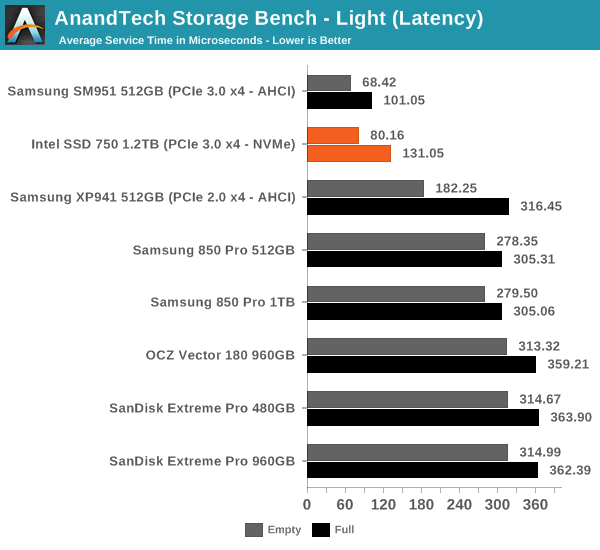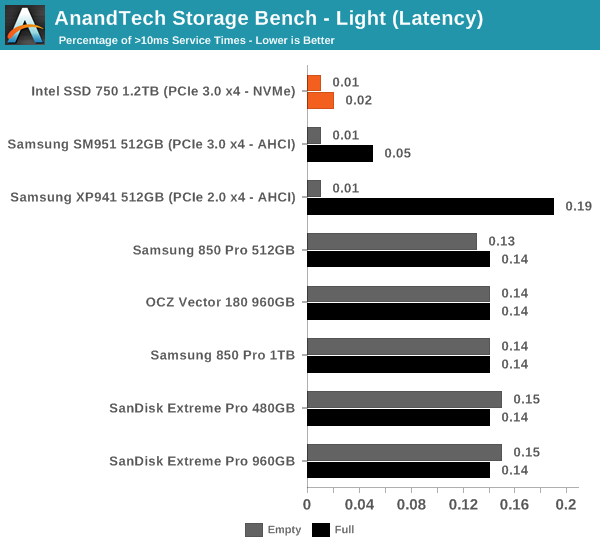Intel SSD 750 PCIe SSD Review: NVMe for the Client
by Kristian Vättö on April 2, 2015 12:00 PM ESTAnandTech Storage Bench - Light
The Light trace is designed to be an accurate illustration of basic usage. It's basically a subset of the Heavy trace, but we've left out some workloads to reduce the writes and make it more read intensive in general.
| AnandTech Storage Bench - Light - Specs | ||||||||||||
| Reads | 372,630 | |||||||||||
| Writes | 459,709 | |||||||||||
| Total IO Operations | 832,339 | |||||||||||
| Total GB Read | 17.97 GB | |||||||||||
| Total GB Written | 23.25 GB | |||||||||||
| Average Queue Depth | ~4.6 | |||||||||||
| Focus | Basic, light IO usage | |||||||||||
The Light trace still has more writes than reads, but a very light workload would be even more read-centric (think web browsing, document editing, etc). It has about 23GB of writes, which would account for roughly two or three days of average usage (i.e. 7-11GB per day).
| AnandTech Storage Bench - Light - IO Breakdown | |||||||||||
| IO Size | <4KB | 4KB | 8KB | 16KB | 32KB | 64KB | 128KB | ||||
| % of Total | 6.2% | 27.6% | 2.4% | 8.0% | 6.5% | 4.8% | 26.4% | ||||
The IO distribution of the Light trace is very similar to the Heavy trace with slightly more IOs being 128KB. About 70% of the IOs are sequential, though, so that is a major difference compared to the Heavy trace.
| AnandTech Storage Bench - Light - QD Breakdown | ||||||||||||
| Queue Depth | 1 | 2 | 3 | 4-5 | 6-10 | 11-20 | 21-32 | >32 | ||||
| % of Total | 73.4% | 16.8% | 2.6% | 2.3% | 3.1% | 1.5% | 0.2% | 0.2% | ||||
Over 90% of the IOs have a queue depth of one or two, which further proves the importance of low queue depth performance.

The same trend continues in our Light trace where the SM951 is still the king of the hill. It's obvious that Intel didn't design the SSD 750 with such light workloads in mind as ultimately you need to have a relatively IO intensive workload to get the full benefit of PCIe and NVMe.












132 Comments
View All Comments
Per Hansson - Saturday, April 4, 2015 - link
It's most likely due to the poor performance of file transfers below 4KB with this drive.Shadowmaster625 - Thursday, April 2, 2015 - link
The funny thing is that the X25-M is STILL a great product. You can buy one on ebay and place it into a new build and it works just fine. And will continue to work just fine for many more years.eanazag - Thursday, April 2, 2015 - link
I have 4 X25-M 80 GB drives in RAID 0. The 750 is cheaper and faster than my setup. Price is based on what I paid several years ago for them.I would need a new motherboard and CPU to make this drive bootable. I do want.
Intel's PCIe lane bottleneck is pathetic. It seems to be a constant concern. X99 and Haswell-E is not the best answer to the problem. I am really skeptical about waiting for Skylake and the associated chipset. Broadwell for desktop hasn't even been released yet. Skylake for desktop will likely be next year at this rate.
DanNeely - Thursday, April 2, 2015 - link
Intel's never waivered from stating that SkyLake will launch on time and that all of the 14nm ramping delays will be absorbed by shortening broadwell's life. At this point I am wondering if desktop broadwell might end up being cut entirely in the mainstream market segment; with only the LGA2011 variant and possibly the LGA1150 celeron/pentium class chips that normally launch about a year after the rest of the product line on the desktop.r3loaded - Friday, April 3, 2015 - link
Skylake will bring 20 PCIe 3.0 lanes on the PCH, in addition to the PCIe 3.0 lanes coming off the CPU (Skylake-E CPUs will introduce PCIe 4.0) as well as support for up to three SATA Express/M.2 devices. Don't worry, Intel is well aware of the bandwidth bottleneck and they're addressing it.Hung_Low - Thursday, April 2, 2015 - link
So is thisi 750 the long rumoured P3500?Shadowmaster625 - Thursday, April 2, 2015 - link
I'm not satisfied with the explanations of why this product is slower than the SM951. By all rights it should be faster. Why would it still get a recommendation by anandtech?Kristian Vättö - Thursday, April 2, 2015 - link
It's only slower in the Heavy and Light traces, which focus more on peak performance rather than consistency. In The Destroyer trace the SSD 750 has significantly lower IO latency and that's what's critical for power users and professionals since it translates to more responsive system. The Heavy and Light traces don't really illustrate the workloads where the SSD 750 is aimed for, hence the SM951 is faster in those.BD2003 - Thursday, April 2, 2015 - link
Is it really measureably more responsive though? I guess I have a hard time believing that latencies measured in microseconds are going to bare out into any real world difference. Maybe it makes a difference on the single digit millisecond scale, but I'm talking real world here. Like is there any scenario where you'd be able to measure the *actual responsiveness*, meaning the time between clicking something and it actually responding to your command is measurably better? Even if it's just something minor like notepad opens in 50ms vs 100ms while you're compiling and backing up at the same time?Their target market is consumers so I feel like they've got to justify it on the basis of real world usage, not theory or benchmarks. From what I'm seeing here the SM951 looks like a better buy in every single way that matters.
SirPerro - Monday, April 6, 2015 - link
It's not about "clicking and responding". It's about different servers/databases handling hundreds of requests per second in a heavily multithreaded scenario.For UI interaction you probably cannot make the difference between this and the cheapest SSD on the market unless compared side by side.
As the review explains, this is targeted to a very specific niche. Whether people understand the scope of that niche or not is a different thing.